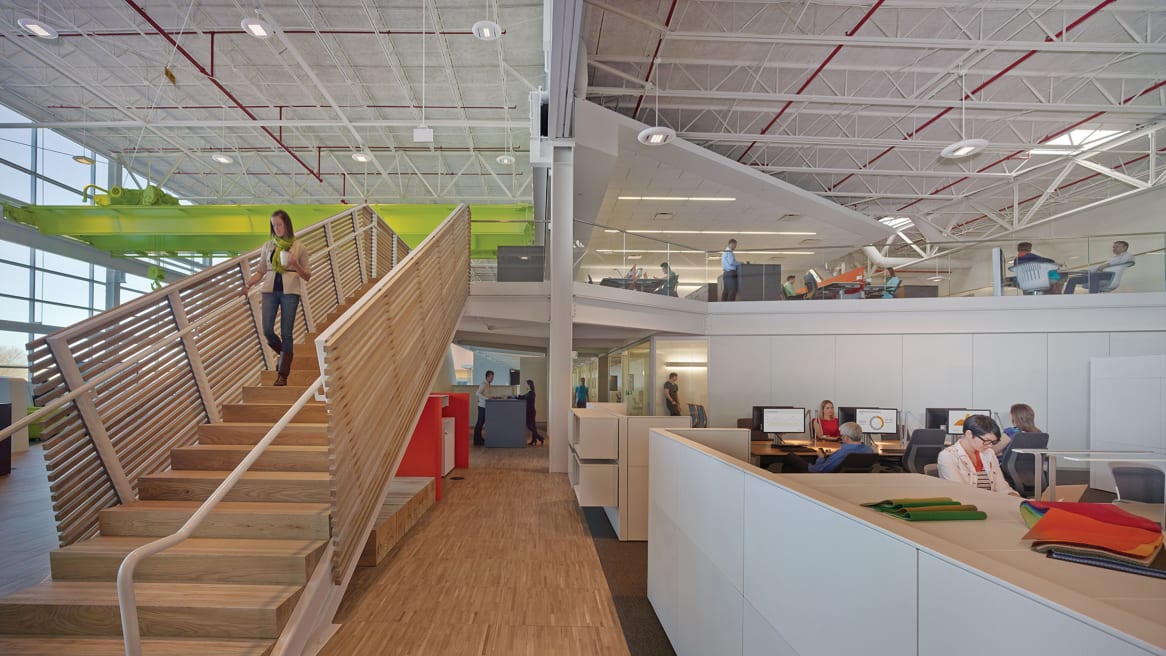Driving Culture Change at Steelcase’s HQ
The company’s leadership decided on a bold plan: reinvent their global headquarters campus in Grand Rapids, MI, leverage the workplace to drive a more mobile, agile and innovative company culture, and use this transformation as a platform for testing new ways of leveraging space to add value to an organization.
How Changing the Workplace Drives Culture Change
Every company is challenged by the new economy. Markets are global, work is mobile and change comes faster than ever. Like many companies faced with this new economy and a global recession, Steelcase had become a leaner organization and needed less real estate, but it also realized the value of the workplace as an essential driver of organizational culture.
The company’s leadership decided on a bold plan: reinvent their global headquarters campus in Grand Rapids, MI, leverage the workplace to drive a more mobile, agile and innovative company culture, and use this transformation as a platform for testing new ways of leveraging space to add value to an organization.
“When our leadership team reviewed the real estate strategy and the financial argument, it was an easy decision on those terms alone. Real estate and costs would be reduced by half. From a numbers perspective, it was an easy call,” says former Steelcase president and CEO Jim Keane. “But as a leadership team we said we wouldn’t do it if it didn’t shape the culture of the company. It was the most important reason to do this project then, and it remains the most important one today.”
A user-centered approach, culture measurement and careful transition management help transform an organization’s culture.
Steelcase employed three critical strategies in reinventing their work environment and work culture:
- a user-centered research, design and development process
- an extensive change management program
- benchmarking the company’s culture and tracking changes over time
Steelcase’s headquarters reinvention, called Connect 12 to reflect how it would better connect a mobile workforce, along with the year the new work environments would begin to open, has produced dramatic results. The project offers insights for other companies who want to fully leverage the work environment as a means of changing their organizational culture.
A user-centered approach
Steelcase’s workplace reinvention began by involving all levels of the company, actively seeking out ideas and insights about the company’s work processes, brand and culture. “We approached the Connect 12 project using our user-centered research, design and development process, the same one we use with companies around the world,” says John Hughes, principal of Applied Research & Consulting (ARC), the workplace consulting practice of Steelcase.
The ARC process employs interactive workshops with executives, managers, and a cross-section of employees from across the company, as well as interviews, e-surveys, work process observations and an in-depth cultural assessment.
A key outcome of this process was a set of critical success factors, the essential things the company must do well to ensure it achieves its goals over the next three to five years. “Identifying these factors helps leadership focus its efforts, determines the direction of the work environment strategy and sets metrics that will be used to validate its success,” says Hughes.
Steelcase’s critical success factors included:
- transforming the organizational culture to become more flexible and agile in conducting its business
- becoming more globally integrated
- re-engaging and re-energizing its people
The planning process also helped determine how much change the company needed and how much it could reasonably handle. On a culture change scale ranging from the maintaining status quo to seeking transformative change, Steelcase set its sights on major change, “a paradigm shift in its space, technology, work process and culture,” says Hughes.
Steelcase set its sights on major change, “a paradigm shift in its space, technology, work process and culture.”
John Hughes principal of Applied Research & Consulting (ARC)
The critical success factors were a result from work conducted in the physical environments, so these factors drove the space planning and design for the entire global headquarters campus. The plan involved reinventing the global headquarters building, enhancing the Steelcase University and Learning Center, and creating a new Innovation Center for the company’s product development teams. These spaces would literally challenge the purpose of the workplace and test new ways of working. Workspace sharing would be common, yet many workers (residents) would still have dedicated spaces. Connection, collaboration, and co-creation would be a natural part of the work day, no matter where employees were located.
The essence of this strategy is best place. “It means you have a choice and control about when, where and how you work, so whatever your work requires, there is a ‘best place’ for you,” says Cherie Johnson, director of global design for Steelcase, whose team lead the design process for the new campus.
The best place strategy supports the wellbeing of employees in a holistic way, considers emotional and cognitive needs as much as physical ones and results in a range of spaces that support the varied ways knowledge workers work today: focused work, collaboration, learning, socializing and rejuvenation.
A network of spaces includes areas for individual work and group work, some of which are “owned” by the individual or team and many that are shared. It is a blend of open spaces and spaces that are enclosed or shielded. It allows people to choose the degree of interaction they want, reflecting an understanding that people need varying degrees of privacy and interaction throughout the day.
One of the most important new spaces is the WorkCafé, an on-site third place and neighborhood crossroads. The headquarters campus is the neighborhood and the WorkCafé is its hub, a combination of workspace, cafeteria and coffee bar. It has the easy functionality of a well-planned office with the vibe of a neighborhood pub. Here people meet, work, network, socialize and reenergize.
Most workplace strategies focus on individual workspaces first, but Steelcase’s best place strategy put the WorkCafé front and center. A prototype space, it was the first to open on campus and a hit from the start. “Everyone comes here. You see leadership, people from other parts of the company, visitors, customers. You meet people face-to-face instead over the phone or email, so it builds rapport and trust across the company, and it nurtures those qualities in your culture,” says Johnson.
“It set the tone for the rest of our campus reinvention by giving everyone the opportunity to experience what democratizing the space means, in a collective way, before anyone had their own personal spaces changed. It reflects the culture and behaviors we want people to adopt.”
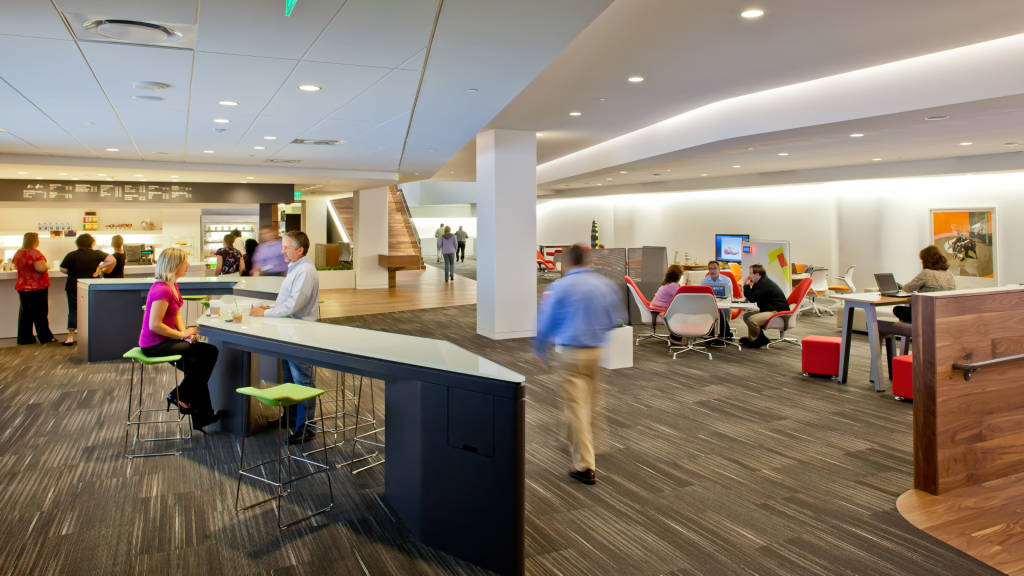
WorkCafé exemplifies leadership’s understanding of the new mobile, global economy and their trust that employees know best how to choose the spaces, technology and tools they need. Employees have choice and control over their work, workspace, and workstyle. This reciprocity nurtures employee engagement and organizational culture.
Working hard at change management
In many organizations, it’s a slow process for managers to develop the trust that workers, no longer assigned to specific desks, will choose the best place to work. Many Steelcase managers were familiar with these new ways of working, including managing distributed workers. To help all managers and staff understand how the company was changing and how its workplace and work processes would reflect that change, Steelcase launched a comprehensive culture change management program two years before opening their new headquarters.
“We began by taking the critical success factors from the ARC engagements and applying those to each space at the micro level. We used a series of engagements and online resources to help managers learn to lead differently, to set objectives and measure performance instead of counting heads and measuring seat time,” says Steve Wolfe, director of corporate human resources.
A culture change management team created tactics such as a leadership guide with detailed information for managers on how to help employees adjust to more mobile workstyles, and online courses on mobility for both leaders and employees.
A key part of the change management effort was forming a pilot group of 80 employees to learn the ropes of mobile work. The group received laptops, smartphones and training in being an effective mobile worker. The employees started working off campus one day a week to experience the ramifications of a mobile workstyle. Over time they evolved into savvy mobile workers and thought leaders for the organization.
“They loved the freedom to choose where they worked best. Before long, other people where calling, asking us how they could get in the pilot,” says Wolfe. The pilot group addressed the next group of employees preparing to move to the new mobile workplace. “It was a good example of peer-to-peer counseling. People responded very positively to it. Later, after those employees moved in and got used to mobile work, they came back and talked to the next group getting ready to move, and so on.”
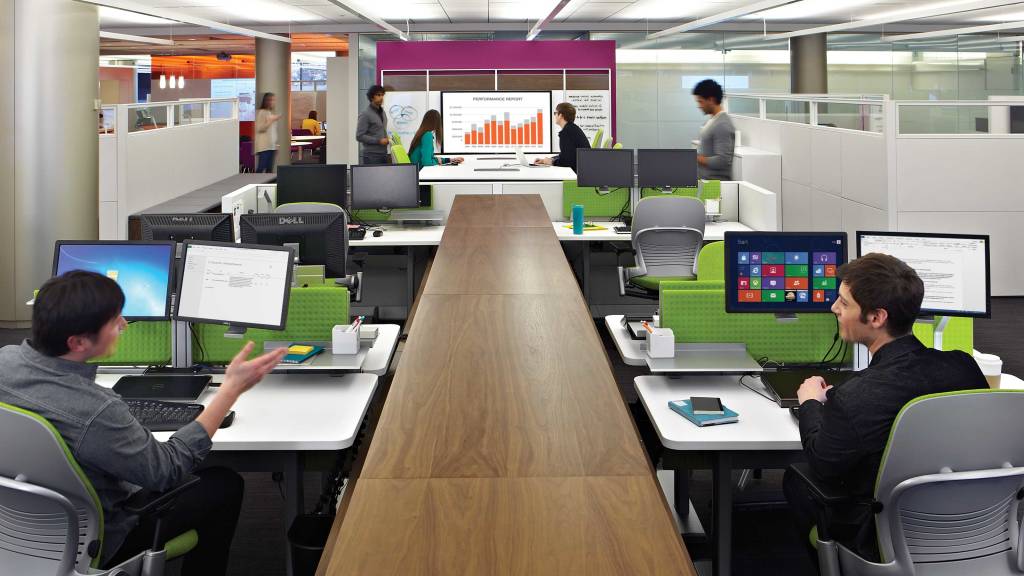
Each floor supports mobile workers with a palette of place – a variety of workspaces for individual and group work. Individuals who require dedicated workspaces have them, but they also can use unassigned spaces and work with others in different areas. All employees, resident or mobile, can use any open workspace on campus.
Before the campus reinvention, 95% of residents at headquarters had assigned desks. But not all employees needed or wanted an assigned workstation, while others had jobs that required them to be at their desks most of the time and needed their own workspaces. To help identify which employees should shift to mobile work, the company asked for volunteers; nearly half (45%) chose to give up their dedicated workspaces in exchange for more flexibility. Since the campus reinvention, the number of employees opting for a mobile workstyle has continued to increase.
Group spaces are common across the campus. In the new Innovation Center, for example, project studios occupy 40% of the footprint, while “front porches” and “back alleys” support a variety of small group work activities. Staffers around the globe keep in touch daily via widely available telepresence settings. The center also includes R&D labs, prototype studio, guest interaction rooms, mobile neighborhoods, enclaves, and a café. “It gives people the variety of spaces and tools they need, yet the floor plate is simple and designed for evolution. We allow the campus spaces to learn with the people who use them,” says Johnson.
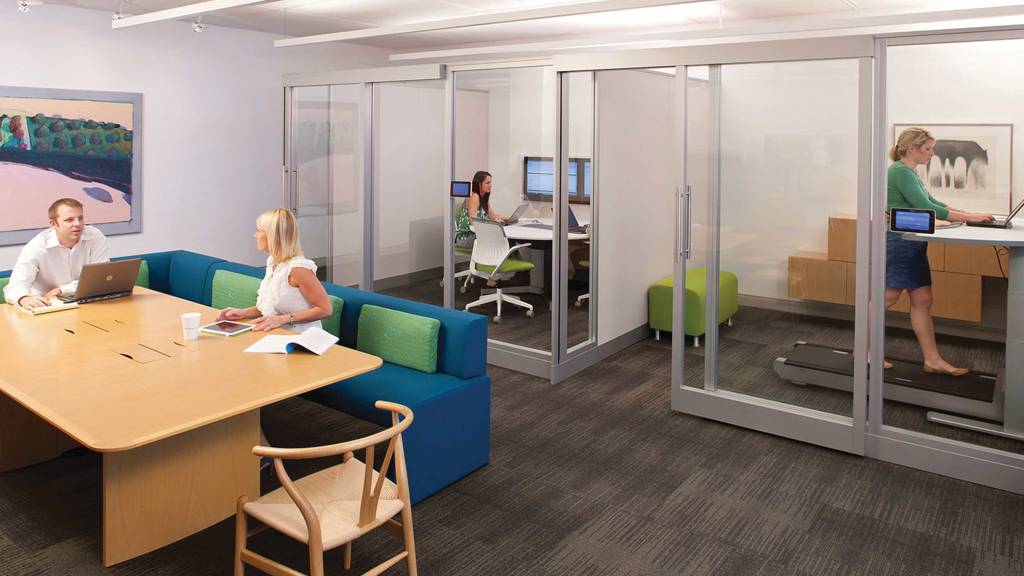
As work on individual floors and departments proceeded, a User Experience process —a suite of tools and techniques for smoothing the transition to new work environments— was developed. “In any move to a new office, some people will be excited and ready for the move, and some will be at least somewhat concerned about how the new space will work, how it will affect them, those sorts of issues. The User Experience Process helped employees understand and prepare for the move,” says Jim Humphries, general manager of sales resources and workplace services.
Measuring an organization’s evolution
Business changes and successful companies and workplaces adjust appropriately. Steelcase’s cultural benchmarking and ongoing measurement helps the company fine tune its work processes, management practices and work environment. Arna Banack, a cultural anthropologist who works with Steelcase to measure and develop its company culture, says changing the physical environment can affect many aspects of organizational culture. “Space can have a direct impact on communication, collaboration, trust, how employees understand the company’s mission and strategy and how they represent the brand, as well as an indirect impact on other contributors to company culture.”
“Space can have a direct impact on communication, collaboration, trust, how employees understand the company’s mission and strategy and how they represent the brand.”
Arna BanackCultural Anthropologist
Culture changes derived from the new global headquarters workspaces are already apparent. While mobile work was not uncommon before the new campus spaces opened, best practices for mobile workstyles, such as how workers can best collaborate with distributed colleagues, or how to keeps all members of a project team fully engaged, were not common knowledge. Thanks to a combination of workplace support and changed behaviors, “mobile work is no longer an issue for the organization,” says Banack. For example, prior to the new headquarters work environments, employees had access to 24 settings with telepresence capability; now they have 58. Not surprisingly, video conferencing has increased at an exponential rate and the number of project teams with distributed workers has similarly expanded.
| Cultural Dimension | October 2013 | April 2010 | Change | % of Change |
| Direction | 3.73 | 3.48 | 0.25 | 7.11% |
| Engagement | 3.90 | 3.76 | 0.13 | 3.55% |
| Execution | 3.48 | 3.36 | 0.11 | 3.34% |
| External Orientation | 3.72 | 3.60 | 0.13 | 3.52% |
| Trust | 3.26 | 3.20 | 0.06 | 1.80% |
Other aspects of the culture have also changed, as illustrated in the table above. Consider direction, a measure of how well Steelcase makes its vision a reality for employees, which has improved dramatically in a short period. Workspaces now better reflect Steelcase’s mission to help organizations achieve higher levels of performance by creating spaces that unlock human promise.
Engagement, a measure of how well employees feel a sense of shared purpose, has also improved. Banack says it can be difficult for an organization with strong engagement scores to keep moving them up. “Engagement was a strength in 2010 and it’s an even greater one now. There’s a very strong sense of shared purpose in the company. This brings people together and unites the organization.
“It might not sound like a 3.5% boost in engagement is a major improvement, but a gain like this is huge in terms of a culture shift in only three years.”
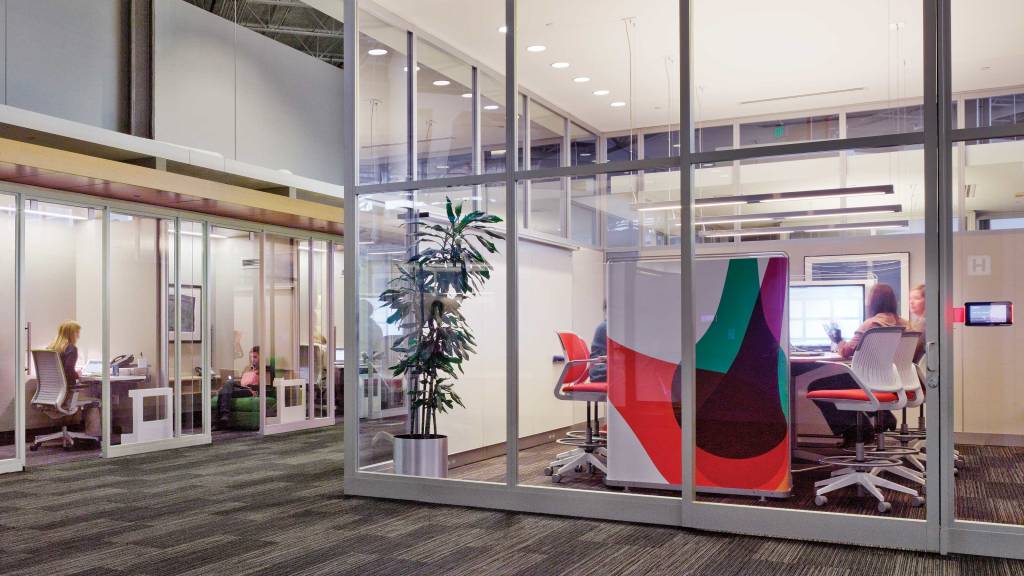
“By giving our employees spaces that reflect the new Steelcase every employee better understands the direction of the company and can work more effectively to make that vision a reality.”
Cherie JohnsonDirector, Global Design
Johnson points out that some corporate spaces hadn’t been renovated in recent years, “and business changes got ahead of how well some spaces performed and how well they allowed employees to perform. Our brands had evolved but our spaces didn’t reflect those changes. How can you expect employees to live your brand if they don’t clearly understand it, if they’re not immersed in it? By giving our employees spaces that reflect the new Steelcase —user-focused, innovative, the product of design thinking— every employee better understands the direction of the company and can work more effectively to make that vision a reality.”
The gain in execution performance points to overall improvement in work processes and employees’ ability to get work done effectively and in a timely manner. The positive change in external orientation supports the critical success factor for becoming more globally integrated, as employees connect more with customers and become greater advocates for customers inside the company.
“Trust was high to begin with, but it’s even higher now. The mobile work environment helps drive that; people understand they’re trusted. You wouldn’t automatically assume that an open environment and mobile work would shift trust scores, but it did,” says Banack.
These and other culture measures have been analyzed by the Applied Research & Consulting team in terms of their impact on the company overall. They point to stronger alignment around the company’s strategy, with employees feeling closer to the larger strategic issues, in part because the physical environment better represents the company’s brand and the vision. Overall, leadership views the new work environments as a major contributor to the company’s gain in market share over the last three years. “A success beyond our wildest dreams,” as one leader put it.
Steelcase leaders see tangible benefits as well. “Our sales support groups have been able to absorb double digit growth in our business two years in a row, without increasing staff. It’s not more hours, it’s just easier to get things done now, to connect, collaborate and make decisions more efficiently.”
Eddy Schmitt, Senior Vice President.
Dave Sylvester, chief financial officer, says feedback from his organization is “off the charts.” Half of his staff are mobile, choosing shared benching workspaces as their daily home base, and 62% report their workplace helps attract and retain employees.
Fine tuning —reconfiguring a space here, changing a furniture application there— is an ongoing extension of the change management program. In one department, more spaces for private conversation and focused work were created. Project teams also needed more spaces they could own for the life of a project, so a few more ‘we/owned’ spaces were added.
Mobile whiteboards are used to capture employee ideas comments as they work in the new spaces. Having employees —not managers— set protocols for how to use spaces empowers workers to take ownership. Free coffee and light snacks seem like small things, but they help draw people to central locations and promote interaction. “It turns department cafes into attractors, places to go to meet people, socialize, catch someone with a question. It’s huge in helping to build the culture,” says Dan White, director of real estate and facilities.
Steelcase designed its work environment to be finessed, tested and tweaked. “We create spaces that users can take advantage of now and tomorrow, but we don’t know how they’ll work next year. These spaces gives them a lot of options and the spaces can change whenever they need to,” says Johnson.
Ready for challenges ahead
Changing company culture is challenging. “Distance is dead, but time zones aren’t. People often work non-traditional hours because their colleagues are in different time zones. It’s a real challenge but it’s a fact of global life and we have to deal with it more effectively,” says Keane.
Overall, the new global headquarters campus uses 48% less real estate. More important, and more valuable results appear in the company’s pre- and post-satisfaction survey results (see sidebar) and how these results reflect a renewed organizational culture.
“We know that people don’t remember much about the words they hear in mission statements or strategy documents,” says Keane. “Instead, they make sense of the company’s direction and purpose—and their place in it—by interacting with other employees and reading the cues signaled by the environment.
“Our new work environments have changed us as an organization. It’s obvious to everyone, including visitors to our spaces who tell us they can sense the essence of our culture and brand through the space.”
Driving Change
By rethinking its real estate strategy, Steelcase was able to reduce the actual footprint of our corporate headquarters campus by 48% and our environmental footprint at the same time. But, more important, the results of pre- and post-Workplace Satisfaction Surveys indicate the impact the changes have made on people, processes and culture is far more valuable.
| Pre-Project | Post Project |
My workplace empowers the creation of new ideas
| 63% | 71% |
I have access to spaces that support the sharing and exchanging of ideas
| 80% | 89% |
I have access to the right technology and tools for my group/team work
| 81% | 87% |
I have access to casual spaces when I need to re-energize
| 56% | 83% |
I am pleased with the views I have from the spaces I work most often
| 61% | 80% |
I am comfortable with the amount of natural light in the spaces I work in the most
| 72% | 89% |
There are a variety of spaces available that meet the needs of my many different daily activities
| 75% | 86% |
My workplace supports learning from my peers and leaders
| 66% | 75% |
My workplace helps attract and retain employees
| 42% | 70% |
My workplace helps facilitate communication between employees
| 80% | 89% |
I can concentrate and focus at my desk.*
| 69% | 63% |
I have access to quiet, more secluded places for focused work and/or private conversations.*
| 81% | 80% |
*The survey results identified the need to balance more private spaces with collaboration settings and Steelcase has since added additional enclaves and other private spaces to the company campus.
Prepare to launch: User Experience
A new work environment is unexplored territory for most companies. People don’t know what to expect, where things are located or even what to pack.
To avoid this kind of culture shock during Steelcase’s move to a new global headquarters, the company employed an extensive User Experience process, a suite of tools and techniques to engage employees and raise their understanding of their department’s new work environment before move-in.
While all employees were briefed extensively about the company’s overall workplace strategy, User Experience was designed to address issues around an individual group or department workplace, such as a floor or wing of a building.
“We developed User Experience about three years ago from our experience helping other companies explore, plan, and provide new work environments. We used it most recently in opening one of the wings of global headquarters,” says Anne Tooley, manager of sales tools and resource development at Steelcase.
Like most major office relocations, Steelcase’s move was a tipping point for the company. New workspaces and ways of working, adopting new protocols and processes. To prepare employees for such substantive change, a number of tools were used to prepare users of the new work environment, including:
- an early survey of employees to explore issues ranging from mobility and privacy to the types of tools they needed and their hopes and concerns for the new workplace
- training sessions and materials: for employees on the company’s new “best place” work strategy, and for managers on how manage a more mobile workforce
- live presentations from facilities, IT, food service and other departments about the services and amenities available in the new workplace
- providing packing strategies and recycling opportunities
- including a concierge and IT support during move-in to help with new technology, office tools and supplies, etc.
- internal communications involving both digital and in-person methods for sharing information, answering questions, and building excitement
- holding a “block party” and an open house after move-in to celebrate the new space and welcome visitors
“Employees and managers across the organization were involved in building the user experience. For example, we hosted information events that brought employees who were already working on a completed floor, to meet with colleagues preparing to move to their own new space. It wasn’t management or HR telling users what to expect, it was their peers. It was very effective,” says Tooley.
Jim Humphries leads the sales resources and workplace services, a group that moved into one of the first areas to be reconfigured in the global headquarters campus. “The key to User Experience is that it involves the users. For example, we formed a transition team with several people from my team and they were able to use proven ideas and activities to engage with their peers and help them prepare for the new work environments. It wasn’t just top down direction from managers, it was individuals working with colleagues. That’s how adoption of new behaviors really happens.”
According to McKinsey, when people are allowed to choose for themselves, they are five times more committed to the outcome. The Steelcase User Experience process increases user readiness for the transition to their new workplace, improving employee awareness and taking ownership for the transition. Humphries says “the pay-off is huge. You reduce anxiety and stress during a major change for the team, ensure happier and more productive employees and a more successful work environment from day one.”
Steelcase Inc., Grand Rapids, Mich.
Credits
Steelcase WorkSpace Futures
Steelcase Applied Research & Consulting
Steelcase Global Design
Shimoda Design


